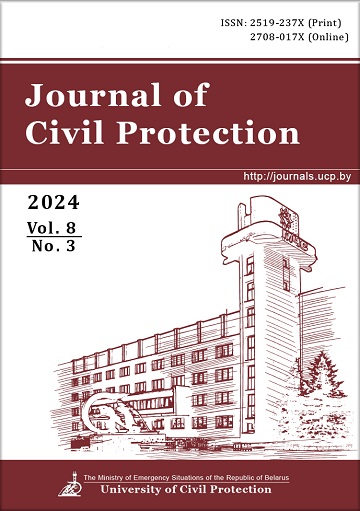Quantitative description of the mechanisms of formation of low multiplicity air-mechanical foam for firefighting needs
DOI:
https://doi.org/10.33408/2519-237X.2024.8-3.276Keywords:
foam, bubble diameter, bubble blowing speed, bubble whipping speed, multiplicity, stability, dispersion, gas content, ejector, mesh, sprinklerAbstract
Purpose. To theoretically evaluate the influence of various factors on the generation of air-mechanical foam obtained in fire extinguishing devices. To compare the obtained data with the results of experimental studies.
Methods. Theoretical and empirical methods of analysis were used in the research process.
Findings. As a result of calculations, the data on the limiting (minimum and maximum) speeds for the liquid flow were obtained, in the range of which the generation of low-expansion air-mechanical foam is ensured for a wide class of foam-generating devices. The mechanisms of foam generation on grids in nozzles of fire trunks by the blowing method, on the surface of foam sprinkler rosettes of automatic fire extinguishing systems by the whipping method, and also by introducing air into the mixing chamber are considered.
Application field of research. The results of the analysis can be used in the development of foam-generating devices, as well as to determine the optimal modes of their operation.
References
Navrotskiy O.D., Kotov S.G. Povyshenie kratnosti peny vodnykh rastvorov PAV [Increasing the foam multiplicity of aqueous solutions of surfactants]. Bezpieczeństwo i Technika Pożarnicza, 2007. Vol. 6, No. 2. Pp. 49–56 (rus). EDN: https://elibrary.ru/STSCWP.
Koksharov A.V., Osipenko S.I. Opredelenie kriticheskikh parametrov obrazovaniya peny na setkakh penogeneratora sredney kratnosti [The determination of the critical parameters of the foam generation on the grid foam generator average multiplicity]. Technosphere safety, 2017. No. 1 (14). Pp. 35–38 (rus). EDN: https://elibrary.ru/YHMVWN.
Bezrodnyy I.F. Zabytye imena – zabytye znaniya… ili «Pochemu ne tushit pena?...» [Forgotten names – forgotten knowledge... or «Why doesn't the foam put out the fire…?»]. Fire and Explosion Safety, 2011. Vol. 20, No. 12. Pp. 49–55 (rus). EDN: https://elibrary.ru/ONZENF.
Kopylov S.N., Shentyapin D.S., Baranov E.V., Grishin V.V., Arkhipov E.E. Issledovanie vliyaniya eksperimental'nogo oborudovaniya na rezul'taty ispytaniy penoobrazovatelya po GOST R 50588–2012 [Study of the experimental equipment influence on the results of frother tests according to GOST R 50588–2012]. Current Fire Safety Issues, 2020. No. 1 (3). Pp. 26–33 (rus). EDN: https://elibrary.ru/GBWGRS.
Kovalev V.I., Erofeeva A.A., Alashkevich Yu.D. Osnovnye fizicheskie parametry protsessa soudareniya strui suspenzii s pregradoy s beznozhevoy razmol'noy ustanovke [Fundamental physical parameters of collision process jets suspension with a barrier in knifeless mechanical installation]. Khimiya rastitel'nogo syr'ya, 2009. No. 3. Pp. 165–168 (rus). EDN: https://elibrary.ru/KYRBHP.
Kamlyuk A.N., Likhomanov A.O., Titovets A.F., Polochanin N.S., Grachulin A.V. Vliyanie razmerov yacheyki setki i rasstoyaniya ot sopla na dispersnost' peny [Influence of the dimensions of the grid cell and the distance from it to the nozzle of the foam-generating device on the foam dispersion]. Journal of Civil Protection, 2022. Vol. 6, No. 4. Pp. 441–450. (rus). DOI: https://doi.org/10.33408/2519-237X.2022.6-4.441. EDN: https://elibrary.ru/GNBQTD.
Popkov V.I., Zatsepina S.V., Shakshin V.P. Gidrodinamicheskoe modelirovanie fil'tratsii pri malykh znacheniyakh kapillyarnogo chisla [Hydrodynamic modeling of filtration at low capillary number values]. Journal of Samara State Technical University. Series: Physical and Mathematical Sciences, 2005. No. 34. Pp. 163–170. (rus). EDN: https://elibrary.ru/ISCORF.
Skripkin A.G., Kol'tsov I.N., Mil'chakov S.V. Eksperimental'nye issledovaniya krivoy kapillyarnogo osusheniya pri PAV-polimernom zavodnenii [Experimental studies of the capillary desaturation curve in polymer-surfactant flooding]. PROneft. Professionally About Oil, 2021. Vol. 6, No. 1. Pp. 40–46. (rus). EDN: https://elibrary.ru/QWLMKE.
Kachanov I.V., Karpenchuk I.V., Pavlyukov S.Yu. Ustanovki avtomaticheskogo pozharotusheniya s predvaritel'noy aeratsiey ognetushashchey rabochey sredy [Automatic fire extinguishing installations with preliminary aeration of the fire extinguishing working environment]. Minsk: Belarusian National Technical University, 2018. 149 p. (rus)
Kann K.B. Kapillyarnaya gidrodinamika pen [Capillary hydrodynamics of foams]. Novosibirsk: Nauka, 1989. 167 p. (rus). ISBN: 5-02-028655-9.
Salkin L., Schmit A., Panizza P., Courbin L. Generating soap bubbles by blowing on soap films. Physical Review Letters, 2016. Vol. 116, No. 7. Article 077801. DOI: https://doi.org/10.1103/PhysRevLett.116.077801.
Kamlyuk A.N., Parmon V.V., Morozov A.A. Stvol pozharnyy ruchnoy universal'nyy kombinirovannyy s raskhodom do 5 l/s i vozmozhnost'yu formirovaniya vozdushno-mekhanicheskoy peny [Universal firefighter manual fire barrel combined with a flow rate of up to 5 l/s and the possibility of forming an air-mechanical foam]. Scientific & Educational Problems of the Civil Protection, 2019. No. 1 (40). Pp. 76–85. (rus). EDN: https://elibrary.ru/ZEUEPZ.
Chan D.Kh., Kamlyuk A.N., Likhomanov A.O., Grachulin A.V., Platonov A.S., Titovets A.F. Otsenka diametra puzyr'kov i skorosti potoka penoobrazuyushchey smesi dlya ikh obrazovaniya na setke penogeneriruyushchikh ustroystv [Evaluation of the bubbles diameter and the blowing speed of the air-mechanical foam forming bubbles on the screen of the foam generators]. Journal of Civil Protection, 2022. Vol. 6, No. 1. Pp. 84–94. (rus). DOI: https://doi.org/10.33408/2519-237X.2022.6-1.84. EDN: https://elibrary.ru/QAEHWG.
Bychkov A.I. O sryve penoobrazovaniya na setkakh [About foaming disruption on the nets]. Proc. of VII All-Union scientific-practical conf. «Gorenie i problemy tusheniya pozharov»: Section «Teplomassoobmen v usloviyakh pozhara». Moscow: FGBU VNIIPO of EMERCOM of Russia, 1981. Pp. 17–20. (rus)
Kamlyuk A.N., Grachulin A.V. Kompressionnaya pena dlya nuzhd pozharnykh podrazdeleniy [Compression foam for the needs of fire departments]: monograph. Minsk: University of Civil Protection, 2019. 224 p. (rus). ISBN: 978-985-590-050-5.
Published
How to Cite
License
Copyright (c) 2024 Kamlyuk A.N.

This work is licensed under a Creative Commons Attribution-NonCommercial 4.0 International License.




















